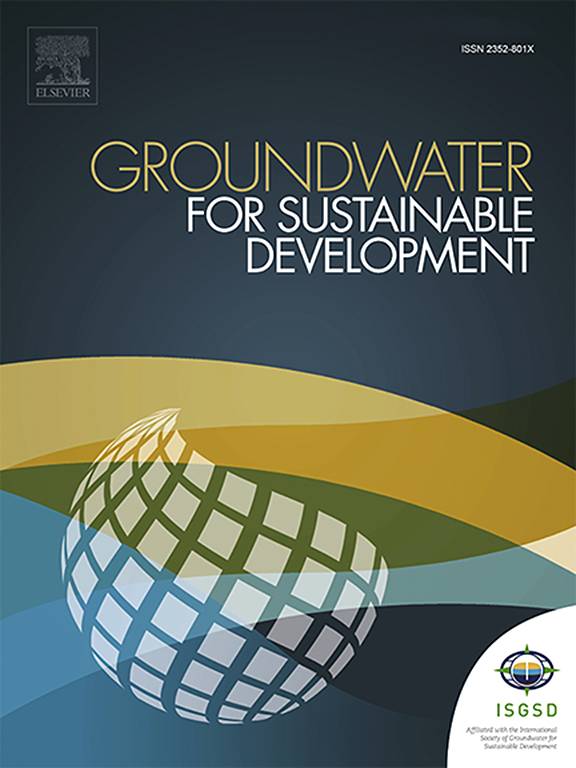Groundwater dynamics and renewal responses in the plain section of the Yongding River, exemplified by extreme precipitation events
IF 4.9
Q2 ENGINEERING, ENVIRONMENTAL
引用次数: 0
Abstract
The groundwater system, though invisible, is vital to the global water cycle, and it is essential to quantitatively assess its renewal capacity in light of climate change and anthropogenic activities. This study investigates the response of groundwater to extreme recharge events, focusing specifically on its renewal capacity and spatial-temporal variations. We analyze representative extreme precipitation events to quantify rebound amplitude, renewal rate, and the proportions of groundwater recharge. Additionally, we examine groundwater dynamics under varying precipitation intensities and initial conditions. The results indicate a strong correlation between groundwater levels (GWLs) and precipitation, characterized by rapid infiltration and mixing, indicating a highly open hydrogeological system. This conclusion is supported by the significant correlation between rainfall intensity and GWLs fluctuations, with correlation coefficients of 0.896, 0.871, and 0.801 from upstream to downstream. The similarities in δD and δ18O, along with the high young water fractions (0.27–0.35) recorded in 2023, further confirm rapid recharge through permeable media. Initial conditions influence lag time and GWLs changes, highlighting the importance of hydrogeological characteristics on groundwater dynamics. Furthermore, spatial variations in GWLs and stable isotopes reveal distinct recharge patterns: concentrated recharge zones upstream (aligned with fault zones) and broader, slower recharge areas downstream. The diminishing hydraulic gradient across the alluvial fan results in reduced flow velocities and renewal rates, while decreasing d-excess suggests evaporative enrichment or mixing with older water downstream. These results provide critical insights into groundwater system's response to extreme precipitation, particularly under climate variability and strong human activities.

以极端降水事件为例的永定河平原区地下水动态与更新响应
地下水系统虽然看不见,但对全球水循环至关重要,鉴于气候变化和人为活动,定量评估其更新能力至关重要。研究了地下水对极端补给事件的响应,重点研究了地下水的更新能力和时空变化。我们分析了具有代表性的极端降水事件,量化了回弹幅度、更新率和地下水补给的比例。此外,我们研究了不同降水强度和初始条件下的地下水动态。结果表明,该地区地下水位与降水具有较强的相关性,具有快速入渗和混合的特征,表明该地区水文地质系统高度开放。降雨强度与gwl波动呈显著相关,从上游到下游的相关系数分别为0.896、0.871和0.801。δD和δ18O的相似性以及2023年记录的高年轻水分数(0.27-0.35)进一步证实了通过渗透介质快速补给。初始条件影响滞后时间和gwl变化,突出了水文地质特征对地下水动力学的重要性。此外,gwl和稳定同位素的空间变化揭示了不同的补给模式:上游集中的补给区(与断裂带一致)和下游更宽、更慢的补给区。冲积扇上水力梯度的减小导致流速和更新速率的降低,而d-excess的减小表明蒸发富集或与下游较老的水混合。这些结果为地下水系统对极端降水的响应提供了重要的见解,特别是在气候变率和强烈的人类活动下。
本文章由计算机程序翻译,如有差异,请以英文原文为准。
求助全文
约1分钟内获得全文
求助全文
来源期刊

Groundwater for Sustainable Development
Social Sciences-Geography, Planning and Development
CiteScore
11.50
自引率
10.20%
发文量
152
期刊介绍:
Groundwater for Sustainable Development is directed to different stakeholders and professionals, including government and non-governmental organizations, international funding agencies, universities, public water institutions, public health and other public/private sector professionals, and other relevant institutions. It is aimed at professionals, academics and students in the fields of disciplines such as: groundwater and its connection to surface hydrology and environment, soil sciences, engineering, ecology, microbiology, atmospheric sciences, analytical chemistry, hydro-engineering, water technology, environmental ethics, economics, public health, policy, as well as social sciences, legal disciplines, or any other area connected with water issues. The objectives of this journal are to facilitate: • The improvement of effective and sustainable management of water resources across the globe. • The improvement of human access to groundwater resources in adequate quantity and good quality. • The meeting of the increasing demand for drinking and irrigation water needed for food security to contribute to a social and economically sound human development. • The creation of a global inter- and multidisciplinary platform and forum to improve our understanding of groundwater resources and to advocate their effective and sustainable management and protection against contamination. • Interdisciplinary information exchange and to stimulate scientific research in the fields of groundwater related sciences and social and health sciences required to achieve the United Nations Millennium Development Goals for sustainable development.
 求助内容:
求助内容: 应助结果提醒方式:
应助结果提醒方式:


